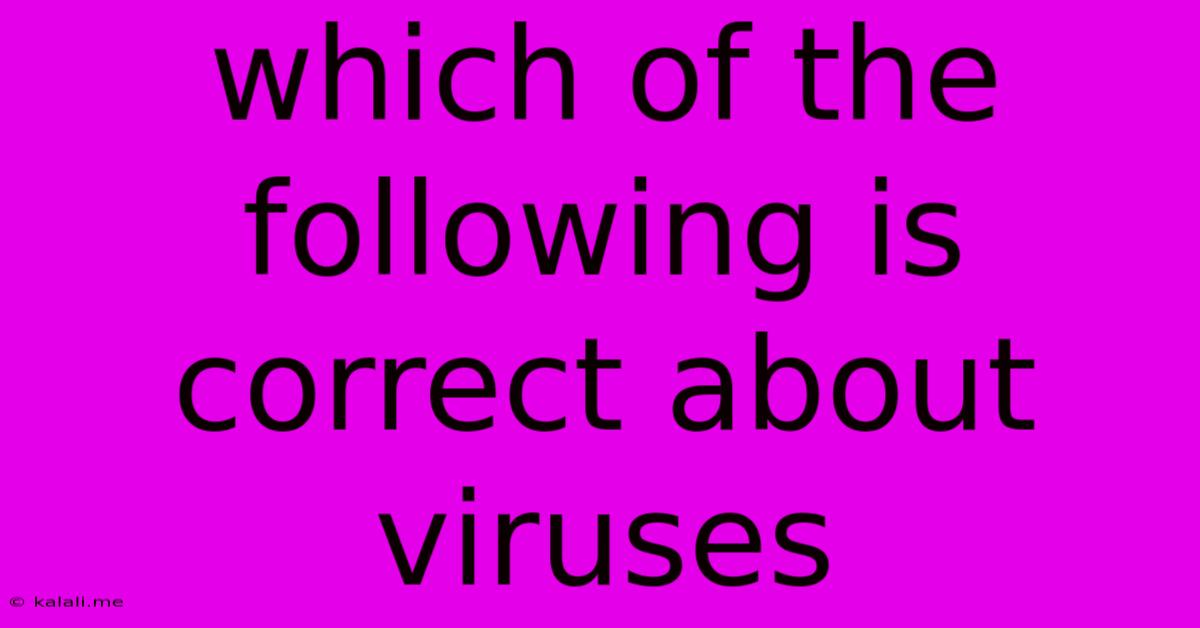Which Of The Following Is Correct About Viruses
Kalali
Jun 13, 2025 · 3 min read

Table of Contents
Which of the following is correct about viruses? Deconstructing Viral Characteristics
Viruses are fascinating and often misunderstood entities. They exist in a grey area between living and non-living things, leading to much debate about their fundamental nature. This article will explore several common statements about viruses and determine which accurately reflect their characteristics. Understanding viral properties is crucial, especially in the context of current global health concerns and advancements in virology. This article will help clarify common misconceptions and provide a more nuanced understanding of these ubiquitous particles.
Key Characteristics of Viruses: Before diving into specific statements, let's establish some fundamental characteristics of viruses. Viruses are obligate intracellular parasites, meaning they require a host cell to replicate. They are incredibly small, much smaller than bacteria, and are composed of genetic material (either DNA or RNA) enclosed in a protein coat called a capsid. Some viruses also have an outer lipid envelope. They lack the cellular machinery needed for independent metabolism and reproduction.
Common Statements about Viruses: Fact or Fiction?
Let's examine some common statements about viruses and assess their accuracy:
1. Viruses are living organisms.
FALSE. While viruses exhibit some characteristics of living things, such as evolution and adaptation through mutation, they lack key features. They cannot reproduce independently, metabolize on their own, or maintain homeostasis. Therefore, the scientific consensus classifies viruses as non-living entities.
2. Viruses can be treated with antibiotics.
FALSE. Antibiotics target bacterial processes. Because viruses lack the cellular structures and metabolic pathways targeted by antibiotics, they are ineffective against viral infections. Antiviral medications work differently, often by targeting specific viral enzymes or processes.
3. Viruses always cause disease.
FALSE. While many viruses cause disease, some have symbiotic or even beneficial relationships with their hosts. Bacteriophages, for example, are viruses that infect and kill bacteria, which can be exploited for therapeutic purposes. Also, some viruses integrate into the host genome without causing immediate harm, sometimes even conferring beneficial traits. The impact of a virus depends heavily on the specific virus and the host.
4. Viruses are highly specific to their hosts.
TRUE. Viruses typically have a very narrow host range, meaning they can only infect specific types of cells or organisms. This specificity is determined by the interaction between viral surface proteins and receptors on the host cell surface. For example, the HIV virus specifically targets certain types of human immune cells.
5. Viruses can be prevented through vaccination.
TRUE. Vaccines work by stimulating the immune system to produce antibodies and memory cells against specific viruses. This preemptive immunity prevents or reduces the severity of infection if the individual is later exposed to the virus. Vaccines are a cornerstone of public health, protecting populations against numerous viral diseases.
6. All viruses have both DNA and RNA.
FALSE. Viruses possess either DNA or RNA, but never both. Their genetic material can be single-stranded or double-stranded, and this characteristic is a key feature used in viral classification.
7. Viruses mutate rapidly.
TRUE. Viruses have a high mutation rate due to their relatively simple replication mechanisms and lack of robust error-checking mechanisms. This rapid mutation contributes to their ability to evade the immune system and develop resistance to antiviral drugs. This is a critical factor in the ongoing evolution of influenza and other viruses.
Conclusion:
Understanding the fundamental characteristics of viruses is crucial for comprehending their impact on human health and the environment. By dispelling common misconceptions and highlighting their unique biological properties, we can better appreciate the complexities of these fascinating and ubiquitous biological entities. This knowledge is vital for developing effective prevention strategies and treatments for viral infections.
Latest Posts
Latest Posts
-
Router Operates In Which Layer Of Osi Model
Jun 14, 2025
-
What Is The Largest Organelle In A Cell
Jun 14, 2025
-
What Is The Major Element Found In Chlorophyll
Jun 14, 2025
-
Atoms In A Molecule Are Held Together By
Jun 14, 2025
-
Comets Are While Asteroids Are
Jun 14, 2025
Related Post
Thank you for visiting our website which covers about Which Of The Following Is Correct About Viruses . We hope the information provided has been useful to you. Feel free to contact us if you have any questions or need further assistance. See you next time and don't miss to bookmark.